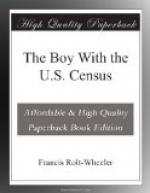“Yes, Mr. Nebett,” was the reply.
“All right,” the other said, “we’ll go into the room.” He pointed out to Hamilton, as they passed from one part of this little building to the other, that each of these percussion caps was attached to a wire which ran through the wall to the little room into which they were going.
“Look out, Mr. Nebett,” said the old man, after he had closed and fastened the heavy door, “and you, young sir, don’t be frightened,” and he pulled the wire hanging overhead.
There was a terrific explosion and a roar, and though Hamilton had been half expecting it, he jumped. Then he laughed.
“I guess I did jump, after all,” he said. “What was that for?”
“To test the strength of the barrels,” said his friend, as the old workman slid back the heavy door. “There, you see,” he added, “one of them did burst.” He pointed to one of the gun barrels rent at the side. “Once in a while,” he continued, “they just go up in pieces, and if you look at the walls and the ceiling you’ll see any number of bits of metal driven in deeply.”
“But he seemed to be putting in an awfully heavy charge,” said the boy.
“We do that in order to be sure that we shall not expend a great deal of labor on a barrel which in the end would fail to pass inspection, and also to safeguard against accident,” the other explained. “We do use a very heavy charge because our guns sell all over the world, and in some countries—England, for instance—the test is extremely severe. It’s a costly process, as it spoils a lot of barrels, but it is better to lose material than to put out a piece of work which might not be trustworthy.”
Hamilton looked around the proof-room carefully. Certainly it seemed to have gone through the wars. From the thick wood huge gashes had been rent, and the entire interior was jagged and splintered.
“How much of a charge do you put to each barrel?” he asked; and when the formula was given him for each of the different styles of rifle, the boy whistled in amazement.
“I should think that any barrels that stood that test could stand anything afterwards,” he said admiringly.
“Well, they do,” the other said. “It’s very seldom that you hear of a first-class gun exploding. I don’t recall a case of one of ours for years and years. And even if by some chance flaw they did, the good ones, being nickel steel, would just make a hole in the barrel,—not fly to pieces. But, as a matter of fact, any barrel that has been through that ‘proof-room’ will have been subjected to the greatest strain it will ever have to undergo, for there is no cartridge made that would have one-half the power in proportion to the size of the barrel.”
From the proof-room Hamilton’s guide led him through different parts of the works, where various machines were employed in preparing and finishing the rough forgings he had seen made and annealed. Thus, for example, in a receiver for a gun stock, one machine worked a bevel edge on it, another bored it to the size of the gun barrel, accurate to the thousandth part of an inch, another pierced the tiny screw holes, and yet other machines made even the minute screw, done, as was explained to Hamilton, so that the threads in each should fit with absolute exactness.




